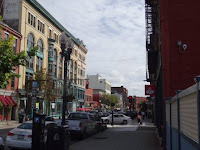The state of Massachusetts has so much history you can virtually set out in any direction from Boston and embark on an adventure into the past. While visiting Boston, my wife and I took a day trip to Lowell, a textile manufacturing center established in the early 19th century by Francis Cabot Lowell. For a hundred years, Lowell represented the American industrial revolution. “King Cotton” was shipped from the South to mills and factories in New England to be made into cloth for the country. Lowell also represents the social history of the United States. The first workers were Massachusetts farm girls recruited with the lure of a life off the farm. As Irish and German immigrants arrived in large numbers in the 1840s, they found jobs in the factories. In the late 1800s, the new immigrants arrived from southern and eastern Europe and then Portugal. As the work force changed the character of the city changed as well, and Lowell became very diverse. Then, the textile industry in Lowell came to an end in 1929 when the Great Depression turned Lowell into a ghost town. In 1978, the Lowell National Historical Park was created for the purpose of rehabilitating over 100 downtown buildings and preserving the city’s unique past. While the textile industry is no longer much of an employer, Lowell has bounced back, thanks to tourism and the universities and hospitals in the area.
 From
the mills, you may want to visit the American Textile History Museum and the
New England Quilt Museum. The latter was
a must-see for my wife, a quilter. The
New England Quilt Museum had a couple of great exhibits for history
lovers. One was an exhibit of modern
quilts inspired by Civil War quilts and fabrics. The other exhibit was of authentic Civil War
quilts.
From
the mills, you may want to visit the American Textile History Museum and the
New England Quilt Museum. The latter was
a must-see for my wife, a quilter. The
New England Quilt Museum had a couple of great exhibits for history
lovers. One was an exhibit of modern
quilts inspired by Civil War quilts and fabrics. The other exhibit was of authentic Civil War
quilts.Art lover? James Whistler’s birthplace in Lowell is open to the public. His father was in charge of the mills’ railroad system at the time of his birth. Literature buff? Jack Kerouac was a Lowell native, and you can connect with the author of On the Road in the Kerouac Commemorative Park on Bridge Street.
Whatever your interests, there’s plenty to see in Lowell.














